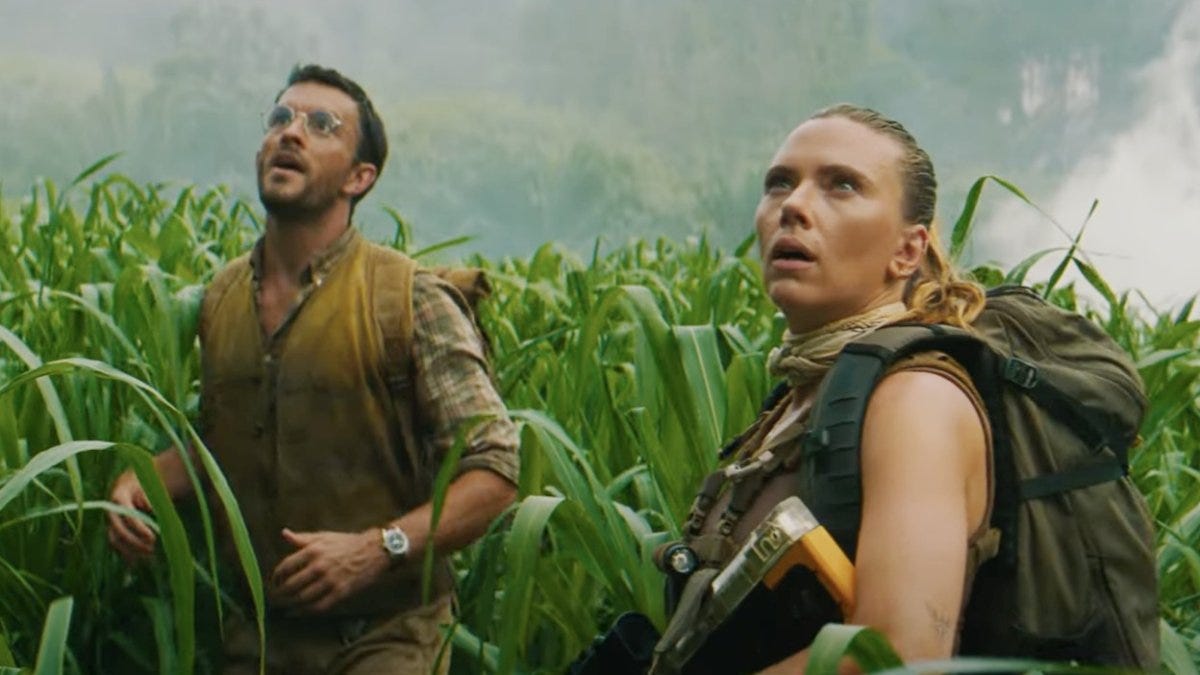In Theatres Now: “Jurassic World: Rebirth” Offers Familiar but Still Wonderful Thrills
Those darn, genetically altered dinosaurs just keep terrorizing the Delgado family
In “Jurassic World: Rebirth,” those darn, genetically altered dinosaurs just keep terrorizing the Delgado family, unwittingly having sailed into the hazardous equatorial zone, and the money-hungry Parker Genix team purposefully there to extract genetic blood samples from one aquatic, one aerial, and one terrestrial specimen. The researchers’ purportedly magnanimous, actually money-driven, goal is DNA information needed to formulate a life-saving heart medicine that will save millions of lives while making the Genix company and their representatives enormously wealthy.
To keep viewers up to speed, introductory scenes include background information and praise for the 167 million year survival of the dinosaurs versus humans’ puny 300,000 years. Establishing further explanatory context, a Brachiosaurus lies edge of frame dying near the Brooklyn Bridge, reinforcing the fact that Earth’s atmosphere supports dinosaurs only in a narrow equatorial band. Those intentionally but unwisely entering this dangerous territory include the tough as nails, covert operations leader Zora Bennett (advancing a strong feminist theme), Essex patrol boat captain Duncan Kincaid, his assistant LeClerc, and three male scientists, not all of them admirable. It takes no time to project who will die and who will survive, but the roller coaster ride is a lot of fun. With the addition of the Delgado family, several implicit and a few explicit comments on racial context enter this equation, as does admiration for the impulse to sacrifice to save others and rejection of those who would let the vulnerable perish. In other words, there is a moral foundation explicitly promoted, never heavy-handed but woven into narrative.
The carnivorous dinosaurs’ potential victims include the civilian Mexican American family consisting of father Reuben Delgado, his repeatedly terrified young daughter Bella, his teenage daughter Teresa, and her occasionally weed-smoking, wacky boyfriend Xavier, all of them inadvertently trapped in a fight for their lives. Their catastrophic encounter with the aquatic Mosasaurus catapults the film into the first dinosaur action sequence. At regular intervals thereafter, characters will face off against spectacular predators on the island where the research group and the family are stranded plus, more claustrophobically, at the derelict site abandoned and left to surviving organisms. Making this all the more terrifying are the InGen hybrid dinosaurs, experiments that ended calamitously. As the 1950s science fiction/monster films already warned the world, human interference in and manipulation of nature results in dire consequences.
Lifting this monster movie above mere action adventure, at which it succeeds impressively, a debate ensues among team members. Should the resulting miracle drug become an open source formula for all or should it be reserved for the few who can afford it? After several casual exchanges about this, everyone can predict the final choice, a principled stance opted for more often in films than in real life. Meantime, indifferent to human debates, the angry, ravenous dinosaurs are ready to feast on any and all of these intruders. Only the herbivore Brontosauruses mind their manners, sweetly entwining necks in loving embrace in one touching scene. As another counterbalance, Bella bonds with a small Aquilops she names Delores, feeding and playing with her pet, mini-dinosaur. Meantime, both the familiar and the hybrid predators make startling appearances: T-Rex, Dilophosaurus, Ankylosaurus, Quetzalcoatlus, Velociraptor, Mutadon (a Velociraptor/Pteranodon hybrid), and more, keeping the film’s audience as apprehensive as the characters.
Suspense is enhanced by the masterful blend of foreground and background details in which CGI is smoothly integrated with live action and through the effective mix of various camera angles. Particularly notable in that regard are scenes in which dinosaurs rise behind characters, often without their awareness.
Editor Jabez Olssen relies on quick cuts in conflict scenes for maximum tension and slows down the pace for dialogue interaction, though even there cinematographer John Mathieson often moves the camera with the characters to keep the tempo brisk. The variety of action scenes keeps the two hours 14 minutes moving along: the Mosasaurus ocean attack, rappelling down a cliff, Ankylosaurus and Velociraptor appearances, and the Tyrannosaurus rex attack as the catalyst for an extended, exhilarating river escape through rapids and rocks. The actors give committed, professional performances, no small feat when reacting to CGI effects to be added later. Scarlett Johansson as special-ops leader Zora Bennett is fierce and determined, resourceful and ingenious in every crisis. She leads paleontologist Dr. Henry Loomis/Jonathan Bailey, captain Kincaid/Mahershala Ali, father Reuben/Manuel Garcia-Rulfo), Martin Krebs/Rupert Friend, and the others.
Director Gareth Edwards wisely relies as much on suspense as on graphic violence. In other words, the audience sees the threat—a shadow, a shape rising in the background—before the characters, adding a breathtaking moment of dread. Alexandre Desplat’s score interprets each scene appropriately, though often silence would work as well or better. In standard, 3-D, 3-D super, or Super projection, “Jurassic World: Rebirth” is screening at cinemas now.
I want to thank Bobby Myers for numerous, helpful details about “Jurassic World: Rebirth,” especially his extensive knowledge about all aspects of dinosaurs.




